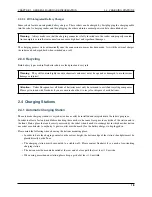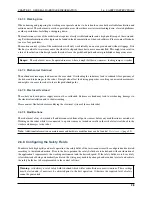
CHAPTER 2. GENERAL HARDWARE INFORMATION
2.3. BATTERIES
2.2.2.2 Serial Number
The second line shows the serial number (SN) of the RelayBoard.
2.2.2.3 Status Information
The third line indicates the current configuration of the software and the state of the hardware components.
The asterisk (*) indicates that the RelayBoard did not yet receive a valid configuration from the control software. After
configuration it will be replaced by a C.
The right part shows the state of all CAN bus devices. Motors are indicated by an M, the IOBoard by an I and the
USBoard by a U. Devices that are not installed are marked by a dash (-) and devices that failed to connect are marked
by an F.
2.3 Batteries
2.3.1 Battery Types
2.3.1.1 AGM Batteries
AGM batteries (Absorbent Glass Mat) are lead acid batteries that contain a fibreglass mesh between the battery plates.
This mesh contains the electrolyte and prevents leakages even if the batteries are stored upside down or when the outer
casing is cracked. This technology is well proven, cheap and widely available. Its drawbacks are a low energy density,
resulting in high weight for a given capacity, and a limited number of charge-discharge cycles.
Their capacity will reduce over time until at some point (approximately after two years of use) the robot’s available
uptime is no longer sufficient and the batteries need to be replaced.
There are several measures to prolong the life of AGM batteries and to save costs and resources:
• Recharge the robot whenever possible.
• Avoid deep discharge and reaching the automatic shut-down voltage.
• Charge the robot while it does not need to move, for example while programming for several hours.
• Do not leave the robot with empty batteries for a long time.
Lead batteries in AGM design are generally very tolerant and significantly less dangerous than traditional lithium-ion-
batteries. Heat, age or wrong treatment may nevertheless cause damages.
Attention:
Regularly check the battery’s condition, at least once every month! The following points indicate
battery damages:
• Deformation or stretching of the battery’s casing
• White or brownish spots at the battery contacts or other metal parts
• Excess heat
• Strong smell of sulphur
• Liquid below the battery
As soon as you notice any kind of damage the batteries must no longer be used and must not be charged any
further! Please contact Neobotix immediately.
16






























